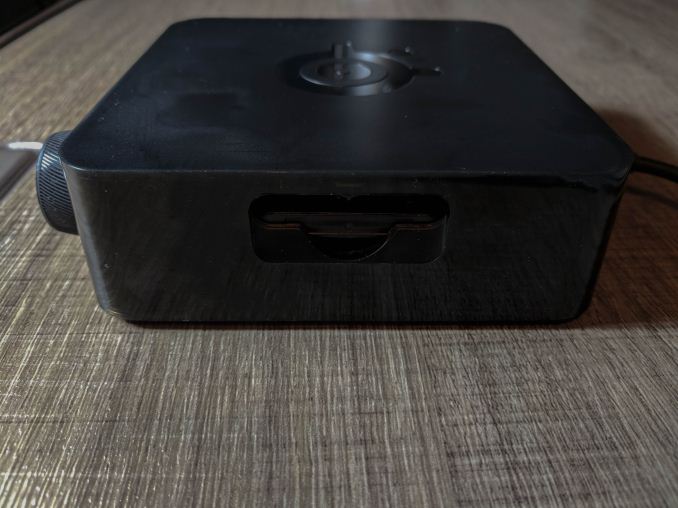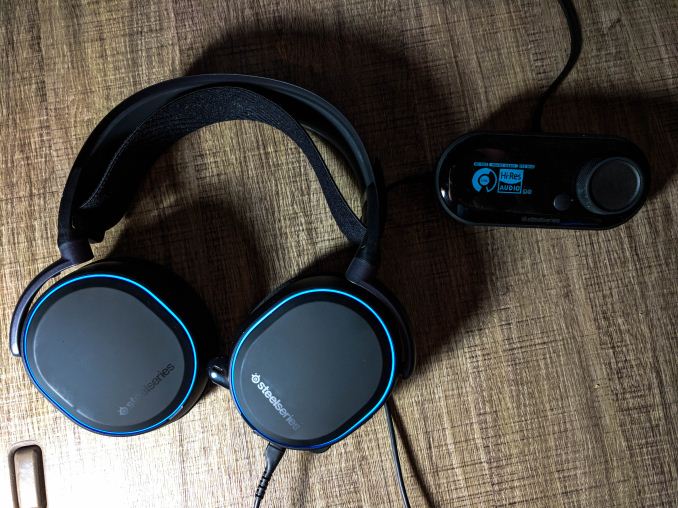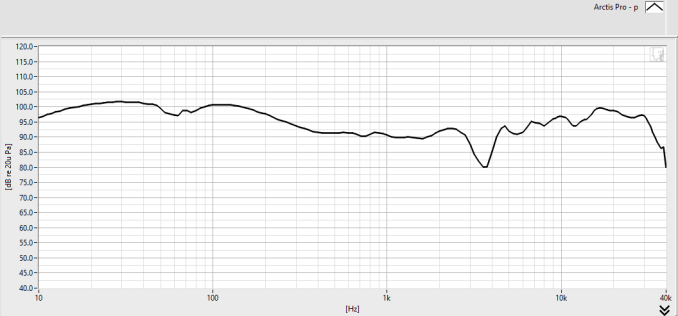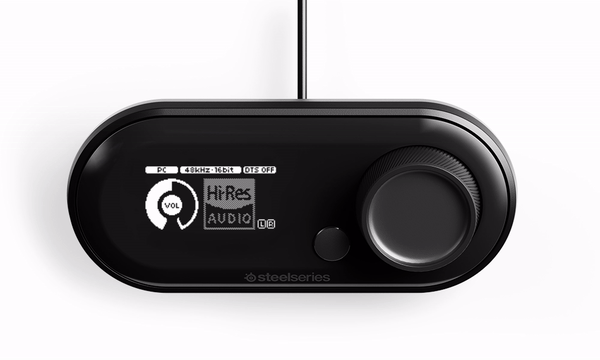The SteelSeries Arctis Pro Gaming Headset Lineup: GameDAC Or Wireless
by Brett Howse on March 13, 2018 9:00 AM EST- Posted in
- Headset
- Audio
- SteelSeries
- Accessories
- Arctis Pro
Performance and Final Words
So enough about how the look, feel, and operate. How do the Arctis Pro sound? In a word: excellent. In our briefing with Brian Fallon, Audio Category Manager for SteelSeries, he emphasised that SteelSeries was going for audio quality here, practically above all other things. The 40 mm drivers they used are the best they’ve ever used in a headset before. The audio circuitry is designed for the lowest noise, and the best clarity. The response of the headset was tuned to ensure no booming base, or low-end cut off. His team has delivered.
The frequency response of the Arctis Pro lineup is simply amazing. It’s rated at 10 Hz to 40 KHz, and what most devices with ratings like that would not tell you is that their 10 Hz rating would be at -10 dB or less compared to 1 Khz. On the Arctis Pro, the 10 Hz response is actually higher than the 1 Khz response. You can clearly hear deep, low, bass notes, and even more than hearing them, you can feel them. This is done with no audible distortion as well, unlike many other headsets I’ve tried, and there’s no large peak at 60-100 Hz or higher which some headsets use to offer a sound with more boominess. Instead you get low, tight bass response.
SteelSeries sent us a frequency response graph of the Arctis Pro, and the graph bears out what you hear when using these headphones. A perfect graph would be a straight line, end to end, but that’s more or less impossible, especially with a single driver, but the Arctis Pro lineup does provide amazing response, with just a small dip around 4 KHz, and amazing low-level response.
Playing back Hi-Res music on the GameDAC is a treat, with clean, sharp, tight sound, at any volume level it’s set at. You don’t have to be an audiophile to appreciate good sound, and although gaming doesn’t yet offer the Hi-Res audio, it likely won’t be long before some games start to support it.
The headsets also support DTS Headphone:X v2.0, which provides positional audio. This is the latest version of DTS’s positional audio for headphones. However it has to be noted if you’re leveraging the Hi-Res input on the GameDAC, DTS Headphone can’t be enabled.
Thanks to both the wired and wireless models sharing the same speaker drivers, both of them offer the same frequency response. The wireless model just has more noise.
Because SteelSeries ships both headsets with adapters to hook to 3.5 mm, it gave the opportunity to hook the Arctis Pro up to several sources to see if there’s an obvious difference in sound quality as well. It was immediately apparent just how poor the audio quality was from my onboard audio. There’s far more noise, less dynamic range, and almost a hollow sound when hooked directly to the motherboard. Hooked to a couple of other audio sources, such as the Blu Yeti, was much better than onboard, but it still wasn’t as clear as the GameDAC. Once again, the hiss and noise was audible, whereas the GameDAC is almost silent when no audio is playing.
Also, since the wireless model offers the same connectors as the wired model, you can also use it with the GameDAC for the best audio experience. It’s a shame SteelSeries doesn’t sell it separate so you could add it to the wireless bundle.
Wrapping things up, it’s pretty easy to say that the Arctis Pro is one of the best gaming headsets on the market. SteelSeries has opted for quality sound, and they’ve delivered in spades. They offer an amazing frequency response on both wired and wireless models.
The GameDAC is simply an amazing piece of kit. A USB DAC and headphone amplifier offers the chance to bypass the often shoddy components built into many computers, and the extra functionality it adds in terms of being able to mix your game and chat volumes on the fly, as well as adding Sidetones to your audio, make it a great addition to any setup. It’ll even output to 3.5 mm if you want to use it with external speakers or another headset. Then you add in the fact that it’s Hi-Res audio certified, and there’s not a lot of devices in this price range that can compete with it.
The wireless model keeps the same audio quality, and adds in dual-batteries for constant power without needing to worry about plugging in the headphones, and adds Bluetooth that can be used concurrently with the wireless connection. The headset can also be used as just a typical wired setup, without needing any power at all. SteelSeries put a lot of thought into the pain points of wireless headphones and addressed most of them.
 Wireless Transmitter showing the battery docking
Wireless Transmitter showing the battery docking
Quality sound, a great microphone, and a comfortable fit. There’s not a lot more you can ask for in terms of a PC headset. The Arctis Pro lineup isn’t inexpensive, starting at $179.99 for the Arctis Pro, $249.99 for the Arctis Pro + GameDAC, and going up to $329.99 for the Arctis Pro Wireless, but if you appreciate quality sound, these are definitely models you need to check out.














32 Comments
View All Comments
aleny2k - Wednesday, March 28, 2018 - link
This is an un-sponsored comment made by my own personal opinion, and speaking on behalf of many people out there who just read this article/hands-on/review, benefited from it, but kept silent or does not give any feedback: I really do enjoy reading through this article and I do learned a lot of information that was not given directly by the manufacturer (and information which cant be found on other websites). Although I must say I was actually hoping there would be more comprehensive content and in-depth review, but since this article never did set out to be a review nor hands-on in the first place, all is forgiven. Please keep up the good work and hopefully, this will not be the last time you dip your toe in the water for headphones.blackmagnum - Thursday, March 15, 2018 - link
Check techpowerup for a second opinion on the same product.Dr. Swag - Tuesday, March 13, 2018 - link
Is this sponsored? Because it sure feels like it but it doesn't say so...Ryan Smith - Tuesday, March 13, 2018 - link
No, it's not.Brett is a closest audio enthusiast and wanted to try out some headphones. That's all.=)
JDBeast - Thursday, March 15, 2018 - link
Almost lost me at the very beginning..."the GameDAC, which is a USB DAC (Digital Audio Converter)"
DAC is Digital-to-ANALOGUE Converter, it's not just used for audio, though that is most common.
Luckily I checked later in the article and it looks like this was a first draft error, as it is correctly explained in the GameDAC section.
JDBeast - Thursday, March 15, 2018 - link
Also I would be curious to know if they have address the screen burn issues with their oled displays. I have the Steelseries Wireless N with basically the same breakout box and it has bad screen burn after a couple of years use. It doesn't affect performance in anyway (of course) but it looks bad and has ruined the resale value of my headset.Brett Howse - Saturday, March 17, 2018 - link
DAC can be referred to as either, but I prefer the original Digital to Analog Converter. I had been reading some press material which referred to it as Audio Converter which made me type that - I fixed it now.halcyon - Friday, March 23, 2018 - link
For those who are wondering... The GameDac is a 2 channel soundcard for Windows.This means it can NOT do proper mutichannel to 3D sound virtualization as ir is being fed only stereo signal.
It will not be able to do proper front to back identification of sounds in 3D games, unlike DTS Headphone (Asus), Creative Sound Blaster 5.1/7.1 cards or Sennheiser GX1000 series.
All it can do is some pseudo room feel with echo/reverb/phase.
i.e. not a true, high end, 3D sound card.
The article should make this very clear.
TechPowerUp review author rates GameDAC below all modern multichannel 3D virtualization sound carda foe gaming directional cues.
Thats what matters in 3D and FPS games.
aleny2k - Wednesday, March 28, 2018 - link
Hi Brett, thank you for the informative hands-on of this product, information which was not provided by their official website or other sites for that matter. I enjoyed it very much. I do have a question about the Arctis Pro Wireless. You did mention that it can be used wired through the gameDAC as well. My question is, do you get exactly the same audio quality (and hi-res Audio) that you get from Arctis Pro+GameDAC, when you wire your Arctis Pro Wireless to the GameDAC? Steelseries is claiming they are using the same speaker and driver for all their Arctis Pro models. Just that because the wireless variant is wireless, it has more noise and distortion and could not achieve the same high audio fidelity as the wired edition (even though SS claimed that wireless can produce lossless audio), mainly because wireless signal is compromised (compressed and distorted) as well as the built-in DAC found INSIDE the Arctis Pro wireless simply isnt ESS Sabre 9018. Technically, when using the wireless headset through the 3.5mm analog wire, it bypasses the built-in DAC found inside the headset, thus emitting the native audio signal from the source without being tampered by the DAC. But since I dont have the headset to test with, I was wondering if you have some answers for this question. I do have a separate DAC and also a couple of audio devices that are capable of producing lossless, hi-res audio. So I was wondering if the Arctis Pro wireless can behave EXACTLY like the Arctis Pro+GameDAC when being used wired. thank you!!Brett Howse - Sunday, April 1, 2018 - link
The Wireless model has the exact same drivers, and the same connectors as well, so you can just plug it in as if it was the wired model and it does bypass the built-in DAC. You can run it without turning on the battery powered circuitry so it sounds just like the wired model when hooked to the DAC.You can also use a 3.5 mm if you want to do the same thing.